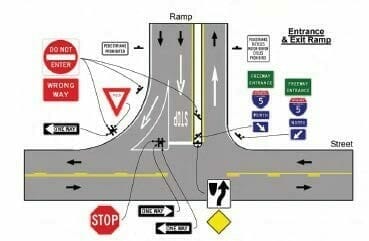E – 1379 Preventing Wrong-Way Driving on Freeways
$175.00
Courses Included
Driving the wrong way on freeways has been a consistent traffic safety problem since the interstate system was opened in the 1950s. From 1996 to 2000 alone, over 1,700 people were killed and thousands more were injured in wrong-way crashes in the United States. The average direct economic loss from such crashes is estimated to be over ten million dollars per year. The purpose of this course is to identify the contributing factors to wrong-way crashes on freeways and to develop promising, cost-conscious countermeasures to reduce these driving errors and their related crashes. Factors found to be significant are alcohol impairment, age, gender, physical condition, driver’s experience and knowledge, time of day, and interchange type. Vehicle type, seat belt use, lighting, roadway alignment, driver age group, first vehicle contact point, and driver condition (blood alcohol concentration level) are shown to have an impact on crash severity. Types of countermeasures such as signage, pavement markings, geometric design, and ITS vehicle detection systems are discussed. Applications to twelve specific interchanges are presented.
Course Outline
This six-hour online course discusses the contributing factors to wrong-way crashes on freeways. A thorough literature review is presented to summarize the best practices on design, safety, and operational issues related to wrong-way driving on freeways by different states in the United States and abroad. Promising, cost-conscious countermeasures to reduce these driving errors and their related crashes are described, and applications of some of the countermeasures to specific traffic sites are given.
A set of short-term, low-cost countermeasures for improving existing wrong-way related signage, pavement markings, and geometric designs were identified. A comprehensive 4 E’s (engineering, education, enforcement, and emergency response) approach was proposed for implementation over the long term. Some advanced technologies can be applied to stop wrong-way driving with the cooperation of law enforcement.
For additional technical information related to this subject, please visit the following websites or web pages:
https://www.fhwa.dot.gov/publications/publicroads/12mayjune/05.cfm
Description
Driving the wrong way on freeways has been a consistent traffic safety problem since the interstate system was opened in the 1950s. From 1996 to 2000 alone, over 1,700 people were killed and thousands more were injured in wrong-way crashes in the United States. The average direct economic loss from such crashes is estimated to be over ten million dollars per year. The purpose of this course is to identify the contributing factors to wrong-way crashes on freeways and to develop promising, cost-conscious countermeasures to reduce these driving errors and their related crashes. Factors found to be significant are alcohol impairment, age, gender, physical condition, driver’s experience and knowledge, time of day, and interchange type. Vehicle type, seat belt use, lighting, roadway alignment, driver age group, first vehicle contact point, and driver condition (blood alcohol concentration level) are shown to have an impact on crash severity. Types of countermeasures such as signage, pavement markings, geometric design, and ITS vehicle detection systems are discussed. Applications to twelve specific interchanges are presented.
Course Outline
This six-hour online course discusses the contributing factors to wrong-way crashes on freeways. A thorough literature review is presented to summarize the best practices on design, safety, and operational issues related to wrong-way driving on freeways by different states in the United States and abroad. Promising, cost-conscious countermeasures to reduce these driving errors and their related crashes are described, and applications of some of the countermeasures to specific traffic sites are given.
A set of short-term, low-cost countermeasures for improving existing wrong-way related signage, pavement markings, and geometric designs were identified. A comprehensive 4 E’s (engineering, education, enforcement, and emergency response) approach was proposed for implementation over the long term. Some advanced technologies can be applied to stop wrong-way driving with the cooperation of law enforcement.
For additional technical information related to this subject, please visit the following websites or web pages:
https://www.fhwa.dot.gov/publications/publicroads/12mayjune/05.cfm
- Understanding the causes of wrong-way driving;
- Knowing the relative ranking of such causes;
- Learning the correlations between various
- contribution factors such as age of driver, alcohol impairment;
- Understanding the use of the four E’s (engineering, education, enforcement, and emergency response) in developing effective countermeasures;
- Knowing the use and drawbacks of automated vehicle detection systems;
- Understanding the importance of sign legibility, placement, size, and wording;
- Knowing the existing state of the art through a thorough literature review;
- Understanding the factors affecting injury severity;
- Understanding the use of a sign package; and
- Becoming familiar with the use of a checklist for identifying the conditions of existing signage, pavement marking, and geometric.






